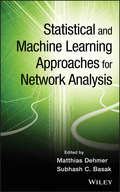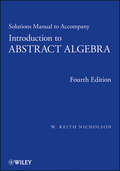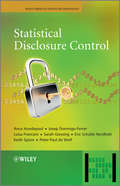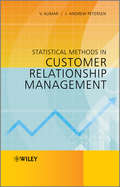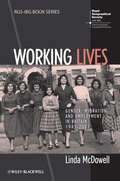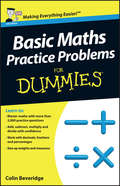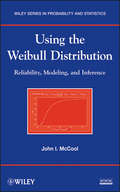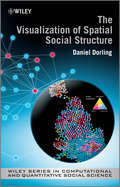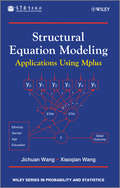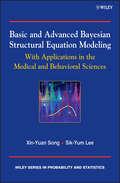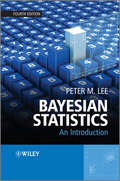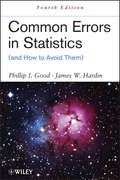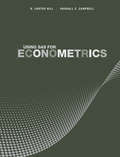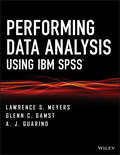- Table View
- List View
Statistical and Machine Learning Approaches for Network Analysis (Wiley Series in Computational Statistics #707)
by Matthias Dehmer Subhash C. BasakExplore the multidisciplinary nature of complex networks through machine learning techniques Statistical and Machine Learning Approaches for Network Analysis provides an accessible framework for structurally analyzing graphs by bringing together known and novel approaches on graph classes and graph measures for classification. By providing different approaches based on experimental data, the book uniquely sets itself apart from the current literature by exploring the application of machine learning techniques to various types of complex networks. Comprised of chapters written by internationally renowned researchers in the field of interdisciplinary network theory, the book presents current and classical methods to analyze networks statistically. Methods from machine learning, data mining, and information theory are strongly emphasized throughout. Real data sets are used to showcase the discussed methods and topics, which include: A survey of computational approaches to reconstruct and partition biological networks An introduction to complex networks—measures, statistical properties, and models Modeling for evolving biological networks The structure of an evolving random bipartite graph Density-based enumeration in structured data Hyponym extraction employing a weighted graph kernel Statistical and Machine Learning Approaches for Network Analysis is an excellent supplemental text for graduate-level, cross-disciplinary courses in applied discrete mathematics, bioinformatics, pattern recognition, and computer science. The book is also a valuable reference for researchers and practitioners in the fields of applied discrete mathematics, machine learning, data mining, and biostatistics.
Solutions Manual to accompany Introduction to Abstract Algebra, 4e, Solutions Manual
by W. Keith NicholsonAn indispensable companion to the book hailed an "expository masterpiece of the highest didactic value" by Zentralblatt MATH This solutions manual helps readers test and reinforce the understanding of the principles and real-world applications of abstract algebra gained from their reading of the critically acclaimed Introduction to Abstract Algebra. Ideal for students, as well as engineers, computer scientists, and applied mathematicians interested in the subject, it provides a wealth of concrete examples of induction, number theory, integers modulo n, and permutations. Worked examples and real-world problems help ensure a complete understanding of the subject, regardless of a reader's background in mathematics.
Solutions Manual to accompany Introduction to Abstract Algebra, 4e, Solutions Manual
by W. Keith NicholsonAn indispensable companion to the book hailed an "expository masterpiece of the highest didactic value" by Zentralblatt MATH This solutions manual helps readers test and reinforce the understanding of the principles and real-world applications of abstract algebra gained from their reading of the critically acclaimed Introduction to Abstract Algebra. Ideal for students, as well as engineers, computer scientists, and applied mathematicians interested in the subject, it provides a wealth of concrete examples of induction, number theory, integers modulo n, and permutations. Worked examples and real-world problems help ensure a complete understanding of the subject, regardless of a reader's background in mathematics.
Statistical Disclosure Control (Wiley Series in Survey Methodology)
by Anco Hundepool Josep Domingo-Ferrer Luisa Franconi Sarah Giessing Eric Schulte Nordholt Keith Spicer Peter-Paul de WolfA reference to answer all your statistical confidentiality questions. This handbook provides technical guidance on statistical disclosure control and on how to approach the problem of balancing the need to provide users with statistical outputs and the need to protect the confidentiality of respondents. Statistical disclosure control is combined with other tools such as administrative, legal and IT in order to define a proper data dissemination strategy based on a risk management approach. The key concepts of statistical disclosure control are presented, along with the methodology and software that can be used to apply various methods of statistical disclosure control. Numerous examples and guidelines are also featured to illustrate the topics covered. Statistical Disclosure Control: Presents a combination of both theoretical and practical solutions Introduces all the key concepts and definitions involved with statistical disclosure control. Provides a high level overview of how to approach problems associated with confidentiality. Provides a broad-ranging review of the methods available to control disclosure. Explains the subtleties of group disclosure control. Features examples throughout the book along with case studies demonstrating how particular methods are used. Discusses microdata, magnitude and frequency tabular data, and remote access issues. Written by experts within leading National Statistical Institutes. Official statisticians, academics and market researchers who need to be informed and make decisions on disclosure limitation will benefit from this book.
Statistical Disclosure Control (Wiley Series in Survey Methodology)
by Anco Hundepool Josep Domingo-Ferrer Luisa Franconi Sarah Giessing Eric Schulte Nordholt Keith Spicer Peter-Paul de WolfA reference to answer all your statistical confidentiality questions. This handbook provides technical guidance on statistical disclosure control and on how to approach the problem of balancing the need to provide users with statistical outputs and the need to protect the confidentiality of respondents. Statistical disclosure control is combined with other tools such as administrative, legal and IT in order to define a proper data dissemination strategy based on a risk management approach. The key concepts of statistical disclosure control are presented, along with the methodology and software that can be used to apply various methods of statistical disclosure control. Numerous examples and guidelines are also featured to illustrate the topics covered. Statistical Disclosure Control: Presents a combination of both theoretical and practical solutions Introduces all the key concepts and definitions involved with statistical disclosure control. Provides a high level overview of how to approach problems associated with confidentiality. Provides a broad-ranging review of the methods available to control disclosure. Explains the subtleties of group disclosure control. Features examples throughout the book along with case studies demonstrating how particular methods are used. Discusses microdata, magnitude and frequency tabular data, and remote access issues. Written by experts within leading National Statistical Institutes. Official statisticians, academics and market researchers who need to be informed and make decisions on disclosure limitation will benefit from this book.
Statistical Methods in Customer Relationship Management
by V. Kumar J. Andrew PetersenStatistical Methods in Customer Relationship Management focuses on the quantitative and modeling aspects of customer management strategies that lead to future firm profitability, with emphasis on developing an understanding of Customer Relationship Management (CRM) models as the guiding concept for profitable customer management. To understand and explore the functioning of CRM models, this book traces the management strategies throughout a customer’s tenure with a firm. Furthermore, the book explores in detail CRM models for customer acquisition, customer retention, customer acquisition and retention, customer churn, and customer win back. Statistical Methods in Customer Relationship Management: Provides an overview of a CRM system, introducing key concepts and metrics needed to understand and implement these models. Focuses on five CRM models: customer acquisition, customer retention, customer churn, and customer win back with supporting case studies. Explores each model in detail, from investigating the need for CRM models to looking at the future of the models. Presents models and concepts that span across the introductory, advanced, and specialist levels. Academics and practitioners involved in the area of CRM as well as instructors of applied statistics and quantitative marketing courses will benefit from this book.
Statistical Methods in Customer Relationship Management
by V. Kumar J. Andrew PetersenStatistical Methods in Customer Relationship Management focuses on the quantitative and modeling aspects of customer management strategies that lead to future firm profitability, with emphasis on developing an understanding of Customer Relationship Management (CRM) models as the guiding concept for profitable customer management. To understand and explore the functioning of CRM models, this book traces the management strategies throughout a customer’s tenure with a firm. Furthermore, the book explores in detail CRM models for customer acquisition, customer retention, customer acquisition and retention, customer churn, and customer win back. Statistical Methods in Customer Relationship Management: Provides an overview of a CRM system, introducing key concepts and metrics needed to understand and implement these models. Focuses on five CRM models: customer acquisition, customer retention, customer churn, and customer win back with supporting case studies. Explores each model in detail, from investigating the need for CRM models to looking at the future of the models. Presents models and concepts that span across the introductory, advanced, and specialist levels. Academics and practitioners involved in the area of CRM as well as instructors of applied statistics and quantitative marketing courses will benefit from this book.
Working Lives: Gender, Migration and Employment in Britain, 1945-2007 (RGS-IBG Book Series)
by Linda McDowellFull of unique and compelling insights into the working lives of migrant women in the UK, this book draws on more than two decades of in-depth research to explore the changing nature of women’s employment in post-war Britain. A first-rate example of theoretically located empirical analysis of labour market change in contemporary Britain Includes compelling case studies that combine historical documentation of social change with fascinating first-hand accounts of women’s working lives over decades Integrates information gleaned from more than two decades of in-depth research Revealing comparative analysis of the similarities and differences in the lives of immigrant working women in post-war Britain Features real-life accounts of women’s under-reported experiences of migration
Working Lives: Gender, Migration and Employment in Britain, 1945-2007 (RGS-IBG Book Series)
by Linda McDowellFull of unique and compelling insights into the working lives of migrant women in the UK, this book draws on more than two decades of in-depth research to explore the changing nature of women’s employment in post-war Britain. A first-rate example of theoretically located empirical analysis of labour market change in contemporary Britain Includes compelling case studies that combine historical documentation of social change with fascinating first-hand accounts of women’s working lives over decades Integrates information gleaned from more than two decades of in-depth research Revealing comparative analysis of the similarities and differences in the lives of immigrant working women in post-war Britain Features real-life accounts of women’s under-reported experiences of migration
Basic Maths Practice Problems For Dummies
by Colin BeveridgeLearn to: Master maths with more than 2,000 practice questions Add, subtract, multiply and divide with confidence Work with decimals, fractions and percentages Size up weights and measures Fun, friendly coaching and all the practice you need to tackle maths problems with confidence and ease In his popular Basic Maths For Dummies, professional maths tutor Colin Beveridge proved that he could turn anyone – even the most maths-phobic person – into a natural-born number cruncher. In this book he supplies more of his unique brand of maths-made-easy coaching, plus 2,000 practice problems to help you master what you learn. Whether you're prepping for a numeracy test or an employability exam, thinking of returning to school, or you'd just like to be one of those know-it-alls who says, 'Oh, that's easy!' about any maths problem that comes your way, this book is for you. Master basic arithmetic, fast – in no time, solving addition, subtraction, multiplication and division problems will seem as easy as tying your shoes Face down fractions – you'll never again feel shy around fractions, decimals, percentages and ratios Juggle weights and measures like a pro – whether it's a question of how much it weighs, how long (or far) it is, or how much it costs, you'll never be at a loss for an answer Make shapes your playthings – circles, squares, triangles and rectangles – you'll measure them, draw them and manipulate them with ease Open the book and find: 2,000 pencil-and-paper practice problems The keys to mastering addition, subtraction, multiplication and division The lowdown on fractions, decimals and percentages Basic geometry made easy How to handle weights, measures and money problems How to read charts, tables and graphs at a glance
Basic Maths Practice Problems For Dummies
by Colin BeveridgeLearn to: Master maths with more than 2,000 practice questions Add, subtract, multiply and divide with confidence Work with decimals, fractions and percentages Size up weights and measures Fun, friendly coaching and all the practice you need to tackle maths problems with confidence and ease In his popular Basic Maths For Dummies, professional maths tutor Colin Beveridge proved that he could turn anyone – even the most maths-phobic person – into a natural-born number cruncher. In this book he supplies more of his unique brand of maths-made-easy coaching, plus 2,000 practice problems to help you master what you learn. Whether you're prepping for a numeracy test or an employability exam, thinking of returning to school, or you'd just like to be one of those know-it-alls who says, 'Oh, that's easy!' about any maths problem that comes your way, this book is for you. Master basic arithmetic, fast – in no time, solving addition, subtraction, multiplication and division problems will seem as easy as tying your shoes Face down fractions – you'll never again feel shy around fractions, decimals, percentages and ratios Juggle weights and measures like a pro – whether it's a question of how much it weighs, how long (or far) it is, or how much it costs, you'll never be at a loss for an answer Make shapes your playthings – circles, squares, triangles and rectangles – you'll measure them, draw them and manipulate them with ease Open the book and find: 2,000 pencil-and-paper practice problems The keys to mastering addition, subtraction, multiplication and division The lowdown on fractions, decimals and percentages Basic geometry made easy How to handle weights, measures and money problems How to read charts, tables and graphs at a glance
Using the Weibull Distribution: Reliability, Modeling, and Inference (Wiley Series in Probability and Statistics #950)
by John I. McCoolUnderstand and utilize the latest developments in Weibull inferential methods While the Weibull distribution is widely used in science and engineering, most engineers do not have the necessary statistical training to implement the methodology effectively. Using the Weibull Distribution: Reliability, Modeling, and Inference fills a gap in the current literature on the topic, introducing a self-contained presentation of the probabilistic basis for the methodology while providing powerful techniques for extracting information from data. The author explains the use of the Weibull distribution and its statistical and probabilistic basis, providing a wealth of material that is not available in the current literature. The book begins by outlining the fundamental probability and statistical concepts that serve as a foundation for subsequent topics of coverage, including: • Optimum burn-in, age and block replacement, warranties and renewal theory • Exact inference in Weibull regression • Goodness of fit testing and distinguishing the Weibull from the lognormal • Inference for the Three Parameter Weibull Throughout the book, a wealth of real-world examples showcases the discussed topics and each chapter concludes with a set of exercises, allowing readers to test their understanding of the presented material. In addition, a related website features the author's own software for implementing the discussed analyses along with a set of modules written in Mathcad®, and additional graphical interface software for performing simulations. With its numerous hands-on examples, exercises, and software applications, Using the Weibull Distribution is an excellent book for courses on quality control and reliability engineering at the upper-undergraduate and graduate levels. The book also serves as a valuable reference for engineers, scientists, and business analysts who gather and interpret data that follows the Weibull distribution
Using the Weibull Distribution: Reliability, Modeling, and Inference (Wiley Series in Probability and Statistics #950)
by John I. McCoolUnderstand and utilize the latest developments in Weibull inferential methods While the Weibull distribution is widely used in science and engineering, most engineers do not have the necessary statistical training to implement the methodology effectively. Using the Weibull Distribution: Reliability, Modeling, and Inference fills a gap in the current literature on the topic, introducing a self-contained presentation of the probabilistic basis for the methodology while providing powerful techniques for extracting information from data. The author explains the use of the Weibull distribution and its statistical and probabilistic basis, providing a wealth of material that is not available in the current literature. The book begins by outlining the fundamental probability and statistical concepts that serve as a foundation for subsequent topics of coverage, including: • Optimum burn-in, age and block replacement, warranties and renewal theory • Exact inference in Weibull regression • Goodness of fit testing and distinguishing the Weibull from the lognormal • Inference for the Three Parameter Weibull Throughout the book, a wealth of real-world examples showcases the discussed topics and each chapter concludes with a set of exercises, allowing readers to test their understanding of the presented material. In addition, a related website features the author's own software for implementing the discussed analyses along with a set of modules written in Mathcad®, and additional graphical interface software for performing simulations. With its numerous hands-on examples, exercises, and software applications, Using the Weibull Distribution is an excellent book for courses on quality control and reliability engineering at the upper-undergraduate and graduate levels. The book also serves as a valuable reference for engineers, scientists, and business analysts who gather and interpret data that follows the Weibull distribution
The Visualization of Spatial Social Structure (Wiley Series in Computational and Quantitative Social Science)
by Danny DorlingHow do you draw a map of 100,000 places, of more than a million flows of people, of changes over time and space, of different kinds of spaces, surfaces and volumes, from human travel time to landscapes of hopes, fears, migration, manufacturing and mortality? How do you turn the millions of numbers concerning some of the most important moments of our lives into images that allow us to appreciate the aggregate while still remembering the detail? The visualization of spatial social structure means, literally, making visible the geographical patterns to the way our lives have come to be socially organised, seeing the geography in society. To a statistical readership visualization implies using data. More widely defined it implies freeing our imaginations. The Visualization of Spatial Social Structure introduces the reader to new ways of thinking about how to look at social statistics, particularly those about people in places. The author presents a unique combination of statistical focus and understanding of social structures and innovations in visualization, describing the rationale for, and development of, a new way of visualizing information in geographical research. These methods are illustrated through extensive full colour graphics; revealing mistakes, techniques and discoveries which present a picture of a changing political and social geography. More complex aspects on the surface of social landscapes are revealed with sculptured symbols allowing us to see the relationships between the wood and the trees of social structure. Today's software can be so flexible that these techniques can now be emulated without coding. This book centres on a particular place and time; 1980s Britain, and a particular set of records; routine social statistics. A great deal of information about the 80s' social geography of Britain is contained within databases such as the population censuses, surveys and administrative data. Following the release of the 2011 census, now is a good time to look back at the past to introduce many new visualization techniques that could be used by future researchers.
The Visualization of Spatial Social Structure (Wiley Series in Computational and Quantitative Social Science)
by Danny DorlingHow do you draw a map of 100,000 places, of more than a million flows of people, of changes over time and space, of different kinds of spaces, surfaces and volumes, from human travel time to landscapes of hopes, fears, migration, manufacturing and mortality? How do you turn the millions of numbers concerning some of the most important moments of our lives into images that allow us to appreciate the aggregate while still remembering the detail? The visualization of spatial social structure means, literally, making visible the geographical patterns to the way our lives have come to be socially organised, seeing the geography in society. To a statistical readership visualization implies using data. More widely defined it implies freeing our imaginations. The Visualization of Spatial Social Structure introduces the reader to new ways of thinking about how to look at social statistics, particularly those about people in places. The author presents a unique combination of statistical focus and understanding of social structures and innovations in visualization, describing the rationale for, and development of, a new way of visualizing information in geographical research. These methods are illustrated through extensive full colour graphics; revealing mistakes, techniques and discoveries which present a picture of a changing political and social geography. More complex aspects on the surface of social landscapes are revealed with sculptured symbols allowing us to see the relationships between the wood and the trees of social structure. Today's software can be so flexible that these techniques can now be emulated without coding. This book centres on a particular place and time; 1980s Britain, and a particular set of records; routine social statistics. A great deal of information about the 80s' social geography of Britain is contained within databases such as the population censuses, surveys and administrative data. Following the release of the 2011 census, now is a good time to look back at the past to introduce many new visualization techniques that could be used by future researchers.
Structural Equation Modeling: Applications Using Mplus (Wiley Series in Probability and Statistics #953)
by Jichuan Wang Xiaoqian WangA reference guide for applications of SEM using Mplus Structural Equation Modeling: Applications Using Mplus is intended as both a teaching resource and a reference guide. Written in non-mathematical terms, this book focuses on the conceptual and practical aspects of Structural Equation Modeling (SEM). Basic concepts and examples of various SEM models are demonstrated along with recently developed advanced methods, such as mixture modeling and model-based power analysis and sample size estimate for SEM. The statistical modeling program, Mplus, is also featured and provides researchers with a flexible tool to analyze their data with an easy-to-use interface and graphical displays of data and analysis results. Key features: Presents a useful reference guide for applications of SEM whilst systematically demonstrating various advanced SEM models, such as multi-group and mixture models using Mplus. Discusses and demonstrates various SEM models using both cross-sectional and longitudinal data with both continuous and categorical outcomes. Provides step-by-step instructions of model specification and estimation, as well as detail interpretation of Mplus results. Explores different methods for sample size estimate and statistical power analysis for SEM. By following the examples provided in this book, readers will be able to build their own SEM models using Mplus. Teachers, graduate students, and researchers in social sciences and health studies will also benefit from this book.
Structural Equation Modeling: Applications Using Mplus (Wiley Series in Probability and Statistics)
by Jichuan Wang Xiaoqian WangA reference guide for applications of SEM using Mplus Structural Equation Modeling: Applications Using Mplus is intended as both a teaching resource and a reference guide. Written in non-mathematical terms, this book focuses on the conceptual and practical aspects of Structural Equation Modeling (SEM). Basic concepts and examples of various SEM models are demonstrated along with recently developed advanced methods, such as mixture modeling and model-based power analysis and sample size estimate for SEM. The statistical modeling program, Mplus, is also featured and provides researchers with a flexible tool to analyze their data with an easy-to-use interface and graphical displays of data and analysis results. Key features: Presents a useful reference guide for applications of SEM whilst systematically demonstrating various advanced SEM models, such as multi-group and mixture models using Mplus. Discusses and demonstrates various SEM models using both cross-sectional and longitudinal data with both continuous and categorical outcomes. Provides step-by-step instructions of model specification and estimation, as well as detail interpretation of Mplus results. Explores different methods for sample size estimate and statistical power analysis for SEM. By following the examples provided in this book, readers will be able to build their own SEM models using Mplus. Teachers, graduate students, and researchers in social sciences and health studies will also benefit from this book.
Basic and Advanced Bayesian Structural Equation Modeling: With Applications in the Medical and Behavioral Sciences (Wiley Series in Probability and Statistics #970)
by Sik-Yum Lee Xin-Yuan SongThis book provides clear instructions to researchers on how to apply Structural Equation Models (SEMs) for analyzing the inter relationships between observed and latent variables. Basic and Advanced Bayesian Structural Equation Modeling introduces basic and advanced SEMs for analyzing various kinds of complex data, such as ordered and unordered categorical data, multilevel data, mixture data, longitudinal data, highly non-normal data, as well as some of their combinations. In addition, Bayesian semiparametric SEMs to capture the true distribution of explanatory latent variables are introduced, whilst SEM with a nonparametric structural equation to assess unspecified functional relationships among latent variables are also explored. Statistical methodologies are developed using the Bayesian approach giving reliable results for small samples and allowing the use of prior information leading to better statistical results. Estimates of the parameters and model comparison statistics are obtained via powerful Markov Chain Monte Carlo methods in statistical computing. Introduces the Bayesian approach to SEMs, including discussion on the selection of prior distributions, and data augmentation. Demonstrates how to utilize the recent powerful tools in statistical computing including, but not limited to, the Gibbs sampler, the Metropolis-Hasting algorithm, and path sampling for producing various statistical results such as Bayesian estimates and Bayesian model comparison statistics in the analysis of basic and advanced SEMs. Discusses the Bayes factor, Deviance Information Criterion (DIC), and $L_\nu$-measure for Bayesian model comparison. Introduces a number of important generalizations of SEMs, including multilevel and mixture SEMs, latent curve models and longitudinal SEMs, semiparametric SEMs and those with various types of discrete data, and nonparametric structural equations. Illustrates how to use the freely available software WinBUGS to produce the results. Provides numerous real examples for illustrating the theoretical concepts and computational procedures that are presented throughout the book. Researchers and advanced level students in statistics, biostatistics, public health, business, education, psychology and social science will benefit from this book.
Basic and Advanced Bayesian Structural Equation Modeling: With Applications in the Medical and Behavioral Sciences (Wiley Series in Probability and Statistics)
by Sik-Yum Lee Xin-Yuan SongThis book provides clear instructions to researchers on how to apply Structural Equation Models (SEMs) for analyzing the inter relationships between observed and latent variables. Basic and Advanced Bayesian Structural Equation Modeling introduces basic and advanced SEMs for analyzing various kinds of complex data, such as ordered and unordered categorical data, multilevel data, mixture data, longitudinal data, highly non-normal data, as well as some of their combinations. In addition, Bayesian semiparametric SEMs to capture the true distribution of explanatory latent variables are introduced, whilst SEM with a nonparametric structural equation to assess unspecified functional relationships among latent variables are also explored. Statistical methodologies are developed using the Bayesian approach giving reliable results for small samples and allowing the use of prior information leading to better statistical results. Estimates of the parameters and model comparison statistics are obtained via powerful Markov Chain Monte Carlo methods in statistical computing. Introduces the Bayesian approach to SEMs, including discussion on the selection of prior distributions, and data augmentation. Demonstrates how to utilize the recent powerful tools in statistical computing including, but not limited to, the Gibbs sampler, the Metropolis-Hasting algorithm, and path sampling for producing various statistical results such as Bayesian estimates and Bayesian model comparison statistics in the analysis of basic and advanced SEMs. Discusses the Bayes factor, Deviance Information Criterion (DIC), and $L_\nu$-measure for Bayesian model comparison. Introduces a number of important generalizations of SEMs, including multilevel and mixture SEMs, latent curve models and longitudinal SEMs, semiparametric SEMs and those with various types of discrete data, and nonparametric structural equations. Illustrates how to use the freely available software WinBUGS to produce the results. Provides numerous real examples for illustrating the theoretical concepts and computational procedures that are presented throughout the book. Researchers and advanced level students in statistics, biostatistics, public health, business, education, psychology and social science will benefit from this book.
Bayesian Statistics: An Introduction
by Peter M. LeeBayesian Statistics is the school of thought that combines prior beliefs with the likelihood of a hypothesis to arrive at posterior beliefs. The first edition of Peter Lee’s book appeared in 1989, but the subject has moved ever onwards, with increasing emphasis on Monte Carlo based techniques. This new fourth edition looks at recent techniques such as variational methods, Bayesian importance sampling, approximate Bayesian computation and Reversible Jump Markov Chain Monte Carlo (RJMCMC), providing a concise account of the way in which the Bayesian approach to statistics develops as well as how it contrasts with the conventional approach. The theory is built up step by step, and important notions such as sufficiency are brought out of a discussion of the salient features of specific examples. This edition: Includes expanded coverage of Gibbs sampling, including more numerical examples and treatments of OpenBUGS, R2WinBUGS and R2OpenBUGS. Presents significant new material on recent techniques such as Bayesian importance sampling, variational Bayes, Approximate Bayesian Computation (ABC) and Reversible Jump Markov Chain Monte Carlo (RJMCMC). Provides extensive examples throughout the book to complement the theory presented. Accompanied by a supporting website featuring new material and solutions. More and more students are realizing that they need to learn Bayesian statistics to meet their academic and professional goals. This book is best suited for use as a main text in courses on Bayesian statistics for third and fourth year undergraduates and postgraduate students.
Bayesian Statistics: An Introduction (A\hodder Arnold Publication)
by Peter M. LeeBayesian Statistics is the school of thought that combines prior beliefs with the likelihood of a hypothesis to arrive at posterior beliefs. The first edition of Peter Lee’s book appeared in 1989, but the subject has moved ever onwards, with increasing emphasis on Monte Carlo based techniques. This new fourth edition looks at recent techniques such as variational methods, Bayesian importance sampling, approximate Bayesian computation and Reversible Jump Markov Chain Monte Carlo (RJMCMC), providing a concise account of the way in which the Bayesian approach to statistics develops as well as how it contrasts with the conventional approach. The theory is built up step by step, and important notions such as sufficiency are brought out of a discussion of the salient features of specific examples. This edition: Includes expanded coverage of Gibbs sampling, including more numerical examples and treatments of OpenBUGS, R2WinBUGS and R2OpenBUGS. Presents significant new material on recent techniques such as Bayesian importance sampling, variational Bayes, Approximate Bayesian Computation (ABC) and Reversible Jump Markov Chain Monte Carlo (RJMCMC). Provides extensive examples throughout the book to complement the theory presented. Accompanied by a supporting website featuring new material and solutions. More and more students are realizing that they need to learn Bayesian statistics to meet their academic and professional goals. This book is best suited for use as a main text in courses on Bayesian statistics for third and fourth year undergraduates and postgraduate students.
Common Errors in Statistics (and How to Avoid Them): Introduction To Statistics Through Resampling Methods And Microsoft Office Excel
by Phillip I. Good James W. HardinPraise for Common Errors in Statistics (and How to Avoid Them) "A very engaging and valuable book for all who use statistics in any setting." —CHOICE "Addresses popular mistakes often made in data collection and provides an indispensable guide to accurate statistical analysis and reporting. The authors' emphasis on careful practice, combined with a focus on the development of solutions, reveals the true value of statistics when applied correctly in any area of research." —MAA Reviews Common Errors in Statistics (and How to Avoid Them), Fourth Edition provides a mathematically rigorous, yet readily accessible foundation in statistics for experienced readers as well as students learning to design and complete experiments, surveys, and clinical trials. Providing a consistent level of coherency throughout, the highly readable Fourth Edition focuses on debunking popular myths, analyzing common mistakes, and instructing readers on how to choose the appropriate statistical technique to address their specific task. The authors begin with an introduction to the main sources of error and provide techniques for avoiding them. Subsequent chapters outline key methods and practices for accurate analysis, reporting, and model building. The Fourth Edition features newly added topics, including: Baseline data Detecting fraud Linear regression versus linear behavior Case control studies Minimum reporting requirements Non-random samples The book concludes with a glossary that outlines key terms, and an extensive bibliography with several hundred citations directing readers to resources for further study. Presented in an easy-to-follow style, Common Errors in Statistics, Fourth Edition is an excellent book for students and professionals in industry, government, medicine, and the social sciences.
Common Errors in Statistics (and How to Avoid Them)
by Phillip I. Good James W. HardinPraise for Common Errors in Statistics (and How to Avoid Them) "A very engaging and valuable book for all who use statistics in any setting." —CHOICE "Addresses popular mistakes often made in data collection and provides an indispensable guide to accurate statistical analysis and reporting. The authors' emphasis on careful practice, combined with a focus on the development of solutions, reveals the true value of statistics when applied correctly in any area of research." —MAA Reviews Common Errors in Statistics (and How to Avoid Them), Fourth Edition provides a mathematically rigorous, yet readily accessible foundation in statistics for experienced readers as well as students learning to design and complete experiments, surveys, and clinical trials. Providing a consistent level of coherency throughout, the highly readable Fourth Edition focuses on debunking popular myths, analyzing common mistakes, and instructing readers on how to choose the appropriate statistical technique to address their specific task. The authors begin with an introduction to the main sources of error and provide techniques for avoiding them. Subsequent chapters outline key methods and practices for accurate analysis, reporting, and model building. The Fourth Edition features newly added topics, including: Baseline data Detecting fraud Linear regression versus linear behavior Case control studies Minimum reporting requirements Non-random samples The book concludes with a glossary that outlines key terms, and an extensive bibliography with several hundred citations directing readers to resources for further study. Presented in an easy-to-follow style, Common Errors in Statistics, Fourth Edition is an excellent book for students and professionals in industry, government, medicine, and the social sciences.
Using SAS for Econometrics
by R. Carter Hill Randall C. CampbellA supplement such as Using SAS for Econometrics is quite essential for use in a classroom environment, for those attempting to learn SAS, and for quick and useful reference. The SAS documentation comes in many volumes, and several are thousands of pages long. This makes for a very difficult challenge when getting started with SAS. This volume spans several levels of econometrics. It is suitable for undergraduate students who will use canned SAS statistical procedures, and for graduate students who will use advanced procedures as well as direct programming in SAS's matrix language, discussed in chapter appendices. Material within the chapters is accessible to undergraduate and/or Masters students, with appendices to chapters devoted to more advanced materials and matrix programming.
Performing Data Analysis Using IBM SPSS
by Lawrence S. Meyers Glenn C. Gamst A. J. GuarinoFeatures easy-to-follow insight and clear guidelines to perform data analysis using IBM SPSS® Performing Data Analysis Using IBM SPSS® uniquely addresses the presented statistical procedures with an example problem, detailed analysis, and the related data sets. Data entry procedures, variable naming, and step-by-step instructions for all analyses are provided in addition to IBM SPSS point-and-click methods, including details on how to view and manipulate output. Designed as a user’s guide for students and other interested readers to perform statistical data analysis with IBM SPSS, this book addresses the needs, level of sophistication, and interest in introductory statistical methodology on the part of readers in social and behavioral science, business, health-related, and education programs. Each chapter of Performing Data Analysis Using IBM SPSS covers a particular statistical procedure and offers the following: an example problem or analysis goal, together with a data set; IBM SPSS analysis with step-by-step analysis setup and accompanying screen shots; and IBM SPSS output with screen shots and narrative on how to read or interpret the results of the analysis. The book provides in-depth chapter coverage of: IBM SPSS statistical output Descriptive statistics procedures Score distribution assumption evaluations Bivariate correlation Regressing (predicting) quantitative and categorical variables Survival analysis t Test ANOVA and ANCOVA Multivariate group differences Multidimensional scaling Cluster analysis Nonparametric procedures for frequency data Performing Data Analysis Using IBM SPSS is an excellent text for upper-undergraduate and graduate-level students in courses on social, behavioral, and health sciences as well as secondary education, research design, and statistics. Also an excellent reference, the book is ideal for professionals and researchers in the social, behavioral, and health sciences; applied statisticians; and practitioners working in industry.
